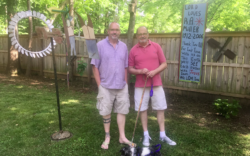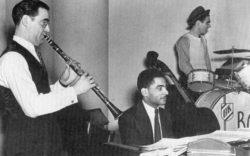Internationally renowned sculptor Alice Aycock loves vortexes and movement, so it was appropriate that she made a whirlwind visit to Athens on Thursday to discuss her work, including “Waltzing Matilda” and “Twin Vortexes.” The two large sculptures are currently on view in the Jane and Harry Willson Sculpture Garden at the Georgia Museum of Art.
The artist had to fly straight back to NYC to do her laundry before heading to Dubai early this morning. “I’m beginning to feel like Hillary Clinton,” she quipped.
In her talk, the artist discussed the many and varied things she loves, including amusement parks, flouncy skirts and strategic war diagrams. She has also found inspiration in the marks of tires in snowy parking lots.
Satellite dishes? Flying saucers? Spinning tops? “I think they’re art,” she enthusiastically exclaimed.
Indeed, it is one of the great pleasures of being an artist. You walk through the world, your eyes wide open, and where others see a plant, a tree, a house or a piece of junk, you see something that becomes a shape or a form or a symbol that ignites your imagination and becomes the path to a sketch or a drawing or, eventually, a massive public sculpture.
The artist, blonde-haired and with a tan gained from working outdoors on installations, wore a scarf which she twisted as she spoke, creating forms not unlike those found in her work. A teacher at the School of Visual Arts (and previously Princeton and Yale), she eagerly shared insights into her process as well as her inspirations.
All of her public sculptures are “highly designed on the computer,” she said. “Things may look like I just thought it up and did it in a drunken stupor…but they are highly planned and engineered.”
Laughing about how detailed and rigorous the planning process can be, she mentioned a town in Florida where she had to jump through many engineering hoops to make her vision a reality. The whole town may be decimated by a hurricane, she joked, but her public sculpture will still be standing after the waters recede.
The works now on exhibit in Athens were originally part of a larger series, “Park Avenue Paper Chase,” which was installed along the New York street. Inspired by many things, on a simple level it is a large-scale and highly engineered response to the idea of pieces of paper being blown up and down the avenue.
Annelies Mondi, deputy director at the museum and the curator of the show, describes Aycock as “one of the icons of artists creating monumental outdoor sculptures that respond to the environment.” She went on to say that “While I have read a good deal about her, it was wonderful having her here in person and hearing her own words about her influences: literature, spaceships, spinning tops, Magical Realism, science and nature.”

Photo Credit: Barbette Houser
The Jane and Harry Wilsson Sculpture Garden at GMOA features work by female artists.
The sculpture garden exhibits the work of female artists only, “thus giving this smaller segment of the artist community a dedicated space,” Mondi says. “While there seem to be far more male sculptors than female, I have developed a healthy list of female artists we would like to have featured in the garden.”
For more information about visiting the sculpture garden, visit georgiamuseum.org. “Twists and Turns: Sculptures by Alice Aycock” will be on display through September 4, 2016.
Like what you just read? Support Flagpole by making a donation today. Every dollar you give helps fund our ongoing mission to provide Athens with quality, independent journalism.











